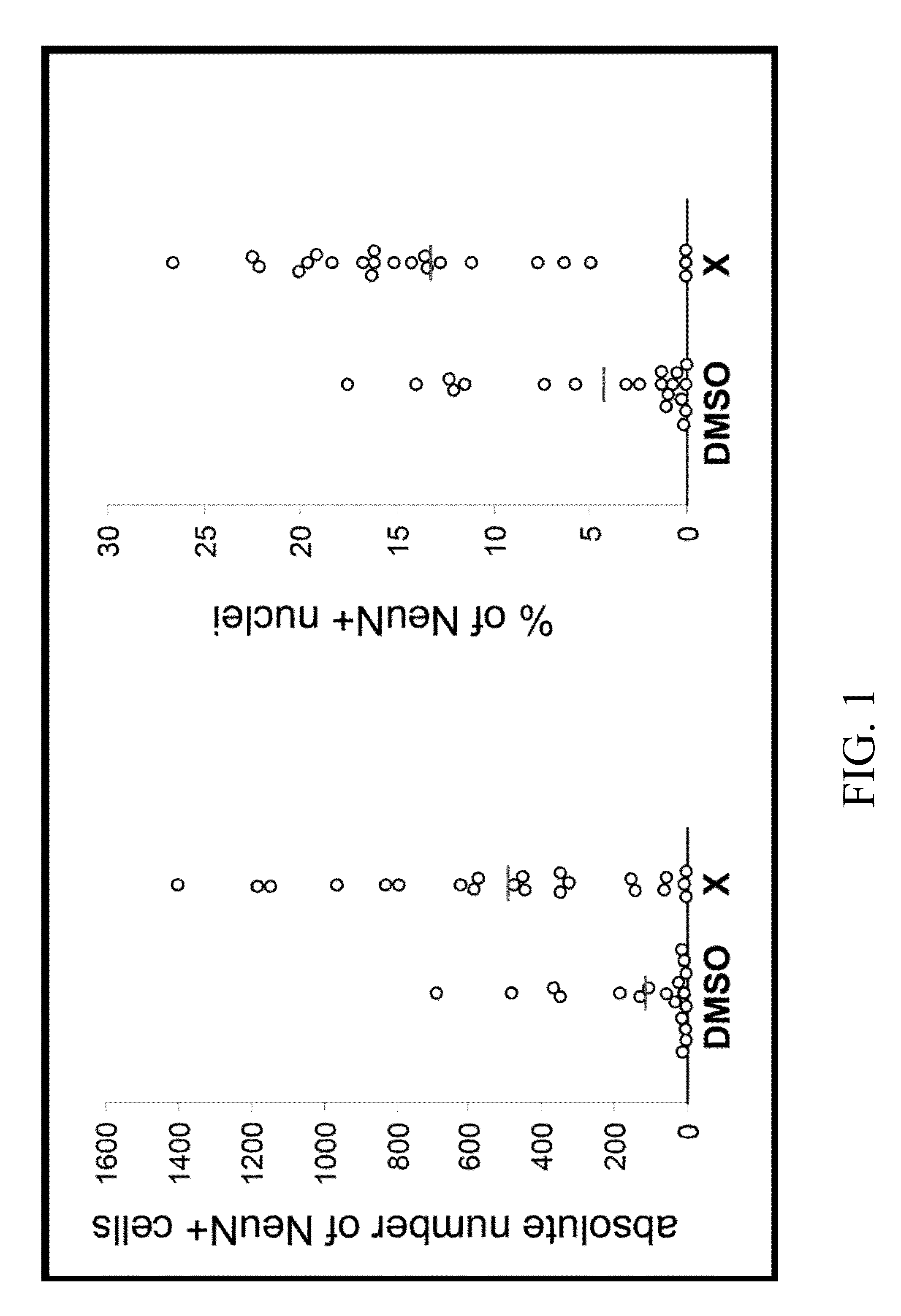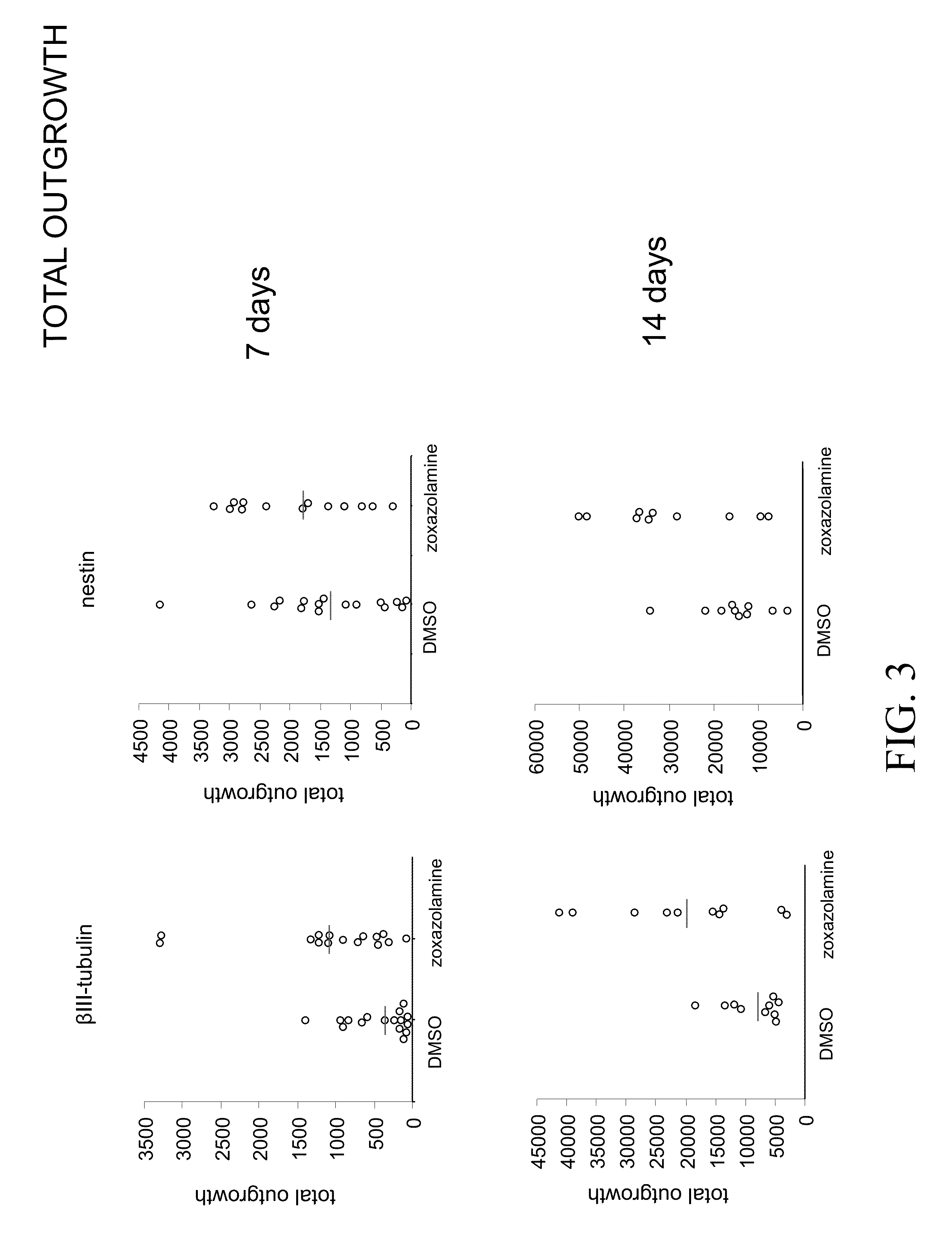Methods and compositions related to dopaminergic neuronal cells
a technology of dopaminergic neuronal cells and compositions, applied in the field of stem cell development, to achieve the effect of enhancing the effect of dopaminergic differentiation and enhancing the efficiency of dopaminergic differentiation of stem cells
- Summary
- Abstract
- Description
- Claims
- Application Information
AI Technical Summary
Benefits of technology
Problems solved by technology
Method used
Image
Examples
example 1
Identification of Zoxazolamine for Dopaminergic Differentiation
[0251]The inventors identified a small molecule zoxazolamine that can promote the differentiation of mouse embryonic stem cells (CGR8 line) into dopaminergic neurons. For example, this molecule can serve in the future as a candidate for ES-derived cells for Parkinson's disease therapy. CGR8 cells were seeded on irradiated PA6 monolayer at the density of 60 cells per well in 96-well (cell culture plates) and zoxazolamine was added to the cells after 24 hours of plating at a final concentration of 10 μm. Cells were differentiated into dopaminergic neurons in 16 days. The dopaminergic differentiation was performed under the gold standard condition as described below in the presence or absence of zoxazolamine. The dopaminergic neurons was quantified by radioligand [3H] Win 35,428 binding as described below. The triplicate signals of enhancement of dopaminergic differentiation by zoxazolamine confirmed the reproducibility and...
example 2
Gold Standard Condition for Dopaminergic Differentiation
[0252]The inventors developed a gold standard for mouse embryonic stem cells (CGR8 line) differentiation into dopaminergic neurons in the presence of small organic compounds that favour dopaminergic neuronal differentiation. This gold standard condition permits the generation of maximum amount of dopaminergic neurons. This gold standard is simple, robust and reproducible. The gold standard was based on the co-culture of mouse embryonic stem cells (CGR8 line) on a monolayer of irradiated PA6 feeder cells isolated from skull bone marrow (Barberi et al. 2003). Dopaminergic differentiation by the present method can be performed in a 96 well plate. This method is particularly well suited for in vitro differentiation.
A) Ratio of CGR8 / PA6
[0253]To determine the optimum ratio of CGR8 / PA6 that provides neuronal differentiation in which the presence of dopaminergic neurons is maximum, the inventors compared between different densities of ...
example 3
[3H] Win 35,428 Binding on DAT Receptor and DA Neurons
[0300]A compatible system was established to read out and quantify dopaminergic neurons. For this purpose, a competitive assay was developed based on radioligand [3H] Win 35,428 that is a ligand which binds specifically to dopaminergic transporter DAT. One of the ultimate goals of the binding assay is to confirm if it is possible to label DAT receptor and dopaminergic neurons differentiated from mouse embryonic stem cells (CGR8 line) by using radioligand [3H] Win 35,428.
[0301][3H] Win 35,428 has been used on cells purified from central nervous system in vivo. For in vitro experiments, [3H] Win 35,428 was mainly used on membranes preparation but has never demonstrated in vitro on ESCderived cells.
[0302]To facilitate the demonstration of this proof of concept, the inventors decided (i) to validate the proof of concept on 6 well plates (easier), (ii) to adapt the binding, if the results are convincing to 96-well culture plates.
[0303...
PUM
| Property | Measurement | Unit |
|---|---|---|
| diameter | aaaaa | aaaaa |
| final volume | aaaaa | aaaaa |
| time | aaaaa | aaaaa |
Abstract
Description
Claims
Application Information
 Login to View More
Login to View More - R&D
- Intellectual Property
- Life Sciences
- Materials
- Tech Scout
- Unparalleled Data Quality
- Higher Quality Content
- 60% Fewer Hallucinations
Browse by: Latest US Patents, China's latest patents, Technical Efficacy Thesaurus, Application Domain, Technology Topic, Popular Technical Reports.
© 2025 PatSnap. All rights reserved.Legal|Privacy policy|Modern Slavery Act Transparency Statement|Sitemap|About US| Contact US: help@patsnap.com



